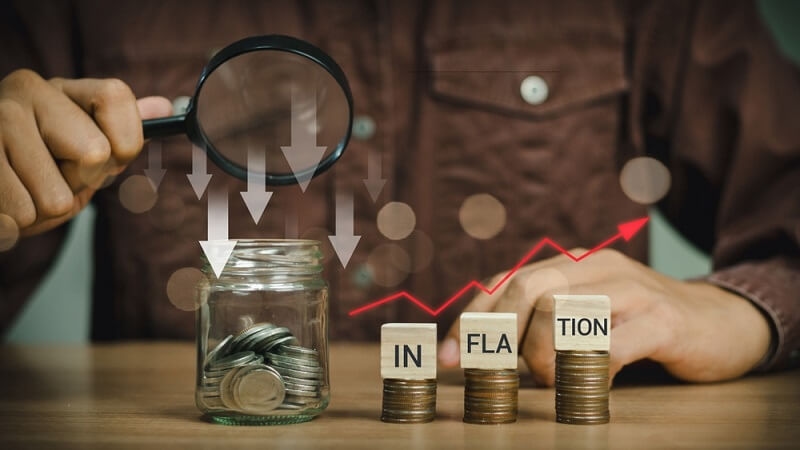
To many people, inflation is an economic concept that does not come home to roost until they see their grocery bill beginning to rise or their savings don't seem to be going as far as they used to. The reality for consumers is that inflation touches almost every element of their financial lives. From the person who sees grocery budget numbers to the saver looking to plan their future, if they do not consider inflation, their purchasing power will be slowly eroded.
This guide will help explain inflation trends in layperson's terms, discuss what rising prices mean for your savings, describe the potential impact for retirement savers, define various economic indicators, examine CPI and PCE, and discuss tangible steps that can be taken to protect your financial future.
Inflation is the continuous increase in prices over time, which diminishes the purchasing power of your money. In other words, as prices increase, the same dollar will buy less than it did before.
Inflation is not necessarily bad. A healthy amount of inflation can be beneficial and encourage economic growth. However, when inflation rises too fast or surprises everyone unexpectedly, it can affect savings, discretionary spending, and investment habits.
Understanding the trend of inflation better allows you to adjust your financial strategy so that your money will work as hard as you do.
There are many causes of inflation:
Policymakers, like central banks, must balance inflation so that it doesn't get too far out of control or drop so low that it causes deflation.
There are two primary sources of measuring inflation for the United States. They are:
Understanding the differences and how CPI vs. PCE explain inflation will help you stay informed in economic discussions and understand how inflation can impact your personal finances.
Inflation is your silent enemy if you’re sitting on large amounts of cash in a traditional savings account.
This means your money is losing value even though it appears to be growing slightly. Over time, the impact of inflation on cash savings can significantly erode the purchasing power of your emergency fund or long-term savings.

Inflation seriously threatens retirees, especially those on fixed incomes or long retirement horizons.
Failing to adjust for inflation in your retirement planning can leave you underfunded in your later years. Understanding how inflation affects retirement is crucial to building a robust financial future.
Consider inflation-adjusted income strategies that grow with or beat inflation to protect your income from rising prices.
The goal is to ensure your income rises at least as fast as inflation to maintain your lifestyle over time.
To protect your investments, explore inflation hedge investment options designed to outperform during inflationary periods.
Diversifying across these assets can help insulate your portfolio from the corrosive effects of inflation.
Emergency funds are essential, but holding too much in low-yield accounts can be risky during high-inflation periods.
This strategy helps preserve your emergency savings while reducing the impact of inflation on cash savings.
Inflation isn’t just a big-picture issue—it affects your daily spending. Groceries, gas, insurance, and utilities all creep upward. If your income doesn’t rise accordingly, your budget can become strained.
Minor tweaks in your spending habits can offset inflation's impact without drastic lifestyle changes.
In high inflation periods, traditional "safe" investments may underperform in real terms. Cash, bonds, and savings accounts often struggle to keep pace with rising prices.
Reevaluating your portfolio through the lens of inflation ensures you're growing not just nominal wealth but absolute purchasing power.
Inflation doesn't just affect your present—it reshapes your plans. Whether it's a child’s education, a dream home, or retirement, the cost of these goals will rise over time.
Thinking in inflation-adjusted terms prevents underfunding and disappointment when planning for primary life goals.
Inflation not only stretches your wallet, it also affects how people feel about their money. Rising prices can lead to stress, fear, or even irrational financial decisions.
Understanding inflation trends explained helps keep your emotions in check. Educated investors are less likely to react impulsively when prices shift.
As prices rise, so can your income, which might push you into higher tax brackets, especially if wages adjust to match inflation.
Tax planning ensures more of your money stays with you as inflation changes your financial picture.
Inflation is a crucial financial concept that’s rarely taught to younger generations. However, it’s never too early to explain how rising prices affect money.
Financial literacy starts at home. A clear grasp of inflation empowers the next generation to make informed choices.
Inflation is an inevitable economic reality, but inflation trends, the inflation impact on cash savings, and other inflation hedge investments can help you protect your savings and investments. If you make informed financial decisions, you can keep up with inflation.
Proactive planning is essential, regardless of your situation—whether you're planning for retirement or just wondering how you will pay next month's bills. Make changes to your portfolio, or find other inflation-resistant asset classes that meet your investment goals, and use a financial advisor if you're not sure what changes would make sense.
This content was created by AI